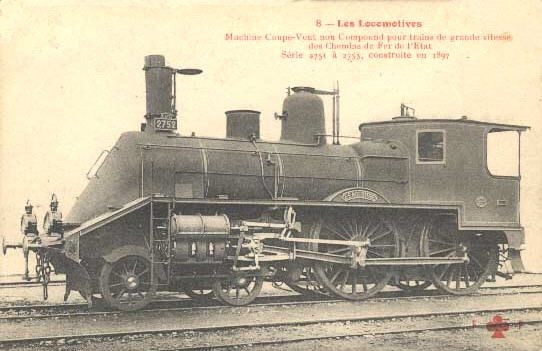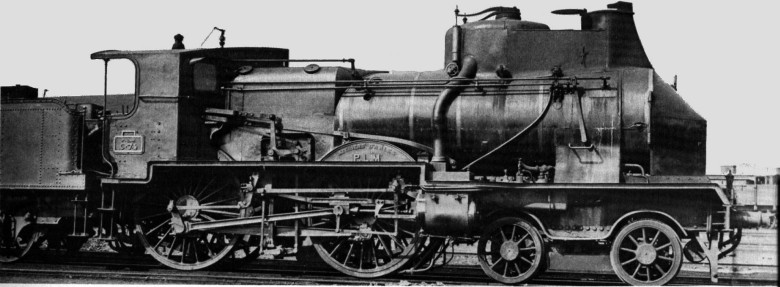As rail speeds increased, attention began to be paid to reducing wind-resistance. The term "streamlining" had not yet been adopted, and the process was called "wind-cutting" or "wind-splitting" and often involved sharp edges intended to cleave the air efficiently. Aerodynamics was in its infancy and it was later realised that in fact a blunt rounded nose creates less drag. (I have often thought that aerodynamics must be the most non-intuitive branch of science around) However, few if any of the schemes tried, be they sharp or blunt, gave a real measurable improvement.
 |
| Left: The first coupe-vent locomotive; No 2072.
This was a type 120 2-4-0 Locomotive from the build series 2069-2099. Note the wedge-shapes between the chimney and the steam dome, and in front of the smokebox and cylinders.
|
One of the first trials was made in 1883 by François Ricour of the French Chemin de Fer de l'Etat (State Railway) network. A 2-4-0 Orléans-type (No 2071 according to some sources, but the picture above clearly shows 2072) was fitted with a wedge-shaped cab and a wedge-shaped housing in front of the smoke box, plus wooden segments to fill the space between the spokes of the wheels. Over 13 months from June 1884 to June 1885, it was claimed that fuel consumption was reduced by 10% or 12%, depending on which source you believe. I for one think both figures are far too optimistic for rudimentary streamlining of relatively slow trains. That doesn't mean that Ricour was a charlatan; but it might mean that the engine crew, with attention focused on them as they proceeded with a highly conspicuous locomotive, consciously or unconsciously drove more carefully; this is called the Hawthorne effect. It is hard to do a double-blind test with locomotives, especially ones that look this peculiar.
Jon Legge tells me that the great W A Tuplin (Bill) used to say that the coal consumption of any steam locomotive could be cut by 10% simply by painting the funnel blue. We have not yet tracked down the source of this quote; I have not so far found it in his book, The Steam Locomotive: its form and function which I highly recommend because of its incisive style and its many nuggets of information I have not seen elsewhere.
French streamlined locomotives were often called locomotives à bec (beaked locomotives).
The second application of streamlining, without filled-in wheels, was on the 4-4-0 Type 220, shown below.

Above: The type 220 express passenger locomotive L'Encloître, No 2752 of Series 2751-2754. (1897) This was a compound locomotive.
I originally thought that the name L'Encloître, which literally means "The Cloistered One" or perhaps "The Enclosed One" was a reference to the housing at the front; this just goes to show how wrong speculation can be. In fact the four locomotives were named after cities, as follows:
2751 : Loudun
2752 : Lencloître
2753 : Villefagnan
2754 : Boursay
| | | | | | | |
|
| Lencloître is a small town in the Vienne département. (district)
Info courtesy of Jean-François Desvignes-Hicks
|
The general public called these locomotives "pig-noses" for reasons that probably don't need spelling out. The streamlining on these machines was limited to the Concorde-nose shroud over the front of the smokebox, and the angled front to the cab.
 |
| Left: Another view of the type 220 L'Encloître.
This appears to be a contemporary postcard.
.
.
Below: A wind-splitting locomotive of the PLM; one of the locomotives à bec.
|

 |
| Left: Another view of the PLM loco. The PLM made full use of the publicity value of the striking appearance of these machines.
A (rather grubby) contemporary postcard, from the Valentine series. Published some time before WW1.
|
Other examples of wind-splitting locomotives on this site are: The Thuile Locomotive and The Prussian State S9, both of which were cabforward designs with sharp vertical leading edges to their cabs.
The almost universal fate of streamlined housings until the demise of steam was their later removal to facilitate maintenance.
Bibliography: "L'évolution du matériel moteur et roulant des chemins defer de l'Etat" by Lucien Maurice Vilain, Paris: pub Vincent, Fréal et Cie, 1967.
 |
| Left: Tragedy on the PLM
A wind-splitting locomotive of the PLM hauling the express to the Cote d'Azur bears down on a level-crossing at Saint-Fons, in February 1909. The old codger (93 years old) was attempting to cross the line in front of the express, and the gatekeeper, Madame Clement, attempted to pull him to safety, but both were killed. She was reported to have previously saved several people in similiar circumstances.
From Le Petit Journal
14 Feb 1909, No 952
|
















